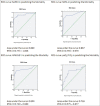Determinants of maternal mortality in a critical care unit: A prospective analysis
- PMID: 34975052
- PMCID: PMC8926236
- DOI: 10.4103/lungindia.lungindia_157_21
Determinants of maternal mortality in a critical care unit: A prospective analysis
Abstract
Introduction: An admission of a pregnant woman to an intensive care unit (ICU) is considered as an objective marker of maternal near miss. Only a few studies from the Indian subcontinent have reported on the ability of ICU scoring systems in predicting the mortality in obstetric patients.
Methods: A prospective analysis of all critically ill obstetric patients admitted to the critical care department was done.
Results: In the period between April 2013 and September 2017, there were 101 obstetric admissions to the critical care ICU. Of these, 82 patients (81.2%) were discharged from the hospital, 18 patients (17.8%) died, and one left against medical advice. The common diagnoses seen in these patients were cardiac failure (n = 39; 38.6%); pregnancy-induced hypertension (n = 26; 25.7%); acute respiratory distress syndrome (n = 20; 19.8%); intra-abdominal sepsis (n = 19; 18.8%); tropical diseases (n = 19; 18.8%); and tuberculosis (n = 13; 12.9%).When we compared the survivors with the nonsurvivors, a higher severity of illness score and a low PaO2/FiO2 were found to increase the odds of death. The area of distribution under the receiver operator characteristic curve was 0.726 (95% confidence interval [CI] = 0.575-0.877), 0.890 (95% CI = 0.773-1.006), 0.867 (95% CI = 0.755-0.979), and 0.850 (95% CI = 0.720-0.980) for the PaO2/FiO2, Simplified Acute Physiology Score (SAPS) II, Sequential Organ Failure Assessment and Acute Physiology and Chronic Health Evaluation (APACHE) II score, respectively, for predicting mortality. The standardized mortality ratio was better with SAPSII than with APACHE II.
Conclusions: Cardiac dysfunction is a leading cause of ICU admission. Obstetric patients frequently require ventilatory support, intensive hemodynamic monitoring, and blood transfusion. The APACHE II score is a good index for assessing ICU outcomes.
Keywords: Echocardiography; maternal near miss; mortality; obstetric critical care.
Conflict of interest statement
None
Figures
Similar articles
-
Performance of the Obstetric Early Warning Score in critically ill patients for the prediction of maternal death.Am J Obstet Gynecol. 2017 Jan;216(1):58.e1-58.e8. doi: 10.1016/j.ajog.2016.09.103. Epub 2016 Oct 15. Am J Obstet Gynecol. 2017. PMID: 27751799
-
Prediction of Severe Maternal Outcome Among Pregnant and Puerperal Women in Obstetric ICU.Crit Care Med. 2019 Feb;47(2):e136-e143. doi: 10.1097/CCM.0000000000003549. Crit Care Med. 2019. PMID: 30422862
-
Critical care in the emergency department: A physiologic assessment and outcome evaluation.Acad Emerg Med. 2000 Dec;7(12):1354-61. doi: 10.1111/j.1553-2712.2000.tb00492.x. Acad Emerg Med. 2000. PMID: 11099425
-
[Comparison of simplified acute physiology score III and other scoring systems in prediction of 28-day prognosis in patients with severe sepsis].Zhonghua Wei Zhong Bing Ji Jiu Yi Xue. 2015 Jun;27(6):454-9. doi: 10.3760/cma.j.issn.2095-4352.2015.06.008. Zhonghua Wei Zhong Bing Ji Jiu Yi Xue. 2015. PMID: 26049183 Chinese.
-
The Simplified Acute Physiology Score III Is Superior to the Simplified Acute Physiology Score II and Acute Physiology and Chronic Health Evaluation II in Predicting Surgical and ICU Mortality in the "Oldest Old".Curr Gerontol Geriatr Res. 2014;2014:934852. doi: 10.1155/2014/934852. Epub 2014 Feb 17. Curr Gerontol Geriatr Res. 2014. PMID: 24696680 Free PMC article. Review.
Cited by
-
Prediction of Maternal Morbidity and Mortality Risk Among Women with Medical Disorders Presenting to Emergency Obstetric care (EMOC): A Prospective Observational Study.J Obstet Gynaecol India. 2023 Dec;73(6):522-530. doi: 10.1007/s13224-023-01859-4. Epub 2023 Nov 4. J Obstet Gynaecol India. 2023. PMID: 38205108 Free PMC article.
-
Determinants of maternal mortality among obstetric patients admitted to intensive care unit of Wolaita Sodo comprehensive specialized hospital, Southern Ethiopia: unmatched case-control study.BMC Pregnancy Childbirth. 2025 Aug 23;25(1):878. doi: 10.1186/s12884-025-07979-1. BMC Pregnancy Childbirth. 2025. PMID: 40849460 Free PMC article.
-
Maternal demography, clinical characteristics, & outcomes at an obstetric intensive care unit of a tertiary-care teaching maternity hospital in the Kashmir Valley.Indian J Med Res. 2025 Mar;161(3):278-286. doi: 10.25259/IJMR_1081_2024. Indian J Med Res. 2025. PMID: 40347505 Free PMC article.
References
-
- Pattinson RC, Hall M. Near misses: A useful adjunct to maternal death enquiries. Br Med Bull. 2003;67:231–43. - PubMed
-
- Tunçalp O, Hindin MJ, Souza JP, Chou D, Say L. The prevalence of maternal near miss: A systematic review. BJOG. 2012;119:653–61. - PubMed
-
- Strand K, Flaatten H. Severity scoring in the ICU: A review. Acta Anaesthesiol Scand. 2008;52:467–78. - PubMed
-
- El-Solh AA, Grant BJ. A comparison of severity of illness scoring systems for critically ill obstetric patients. Chest. 1996;110:1299–304. - PubMed
LinkOut - more resources
Full Text Sources
Miscellaneous


